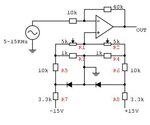franticEB
Full Member level 3
Hi, i've found the circuit shown in figure below

the circuit connected to the positive pin of operational amplifier seems to be useful to regulate the offset of OP AMP by trimming the value of resistors R1 and R2.
I don't understand how this circuit works and how it is able to regulate the offset, could you help me please?

the circuit connected to the positive pin of operational amplifier seems to be useful to regulate the offset of OP AMP by trimming the value of resistors R1 and R2.
I don't understand how this circuit works and how it is able to regulate the offset, could you help me please?